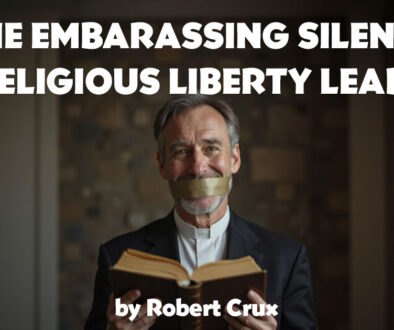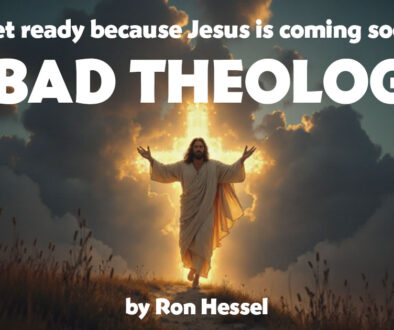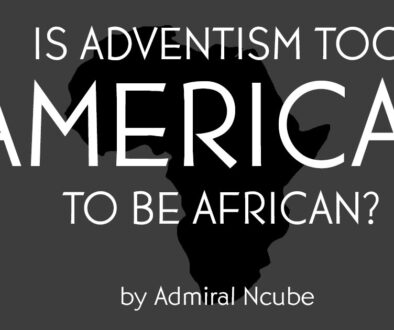Negative Eschatology: Embracing the Mysteries of Our Afterlife
by Reinder Bruinsma | 30 July 2025 |
Professor Rik Torfs belongs to that small group of erudite people who have the gift of communicating their insights in accessible, enriching, and often surprising ways. He is a Belgian professor in canonical law. I became acquainted with him in 1997 when I was involved with the organization of a major congress in Hungary about the new religious realities in Eastern Europe, and he accepted my invitation to be one of the speakers at that event.
 Torf has remained a loyal member of the Roman Catholic Church, though he admits that his work in the domain of canonical law has often confronted him with the less pleasant aspects of church life. But in spite of its many flaws, he remains positive about his church. A recent book by Torfs is entitled The Church Is Fantastic. (If you want to read it, you will have to learn the Dutch language!)
Torf has remained a loyal member of the Roman Catholic Church, though he admits that his work in the domain of canonical law has often confronted him with the less pleasant aspects of church life. But in spite of its many flaws, he remains positive about his church. A recent book by Torfs is entitled The Church Is Fantastic. (If you want to read it, you will have to learn the Dutch language!)
Torfs is honest about his church’s failures but also expresses his deep appreciation for the good things it does. He regrets that his church wastes too much energy on issues of secondary importance, while neglecting the central aspects of the Christian faith: the hope of a new life and a new world. It is, he says, a key responsibility of the Christian church “to keep the pilot light of the resurrection burning.”
There is one concept in this book that intrigued me in a special way: Torfs uses the expression negative eschatology. I wondered: could this help me to deal more satisfactorily with some of the problematic aspects of traditional Adventist eschatology?
Negative theology
The concept of a negative eschatology harkens back to the historical via negativa—the way of the negative, or negative theology. Via negativa says that because God is so great, so mysterious, and so far beyond our human understanding, we can best understand God by saying what God is not, rather than by saying what God is. It seems to me that we Adventist Christians could benefit from a dose of “negative theology”: by focusing on what God is not, we open ourselves to the mystery and greatness of God that our human minds can never fully grasp, which helps us to stay humble and not box God in.
A too concrete picture?
Traditional Adventist teaching and preaching about end-time events and the hereafter has tended to be rather concrete. Few books I have read about this topic are as concrete as Heaven by Randy Alcorn, a book from Tyndale Publishing House that has sold more than a million copies since it was first published in 2004, and has been translated into several other languages. Alcorn assures us:
“Not only will God come to dwell with us on Earth, He will also bring with Him the New Jerusalem, and the entire city of people, structures, streets, walls, rivers, and trees that is now in the present, intermediate Heaven. If you have ever seen a house being relocated, you will appreciate what a massive undertaking it is. God will relocate an entire city. . . . It’s a vast complex containing, perhaps, hundreds of millions of residences” (pp. 185, 186).
Alcorn continues:
“We don’t need to worry that Heaven will be crowded. The ground level of the city will be nearly two million square miles. This is forty times bigger than England, and fifteen thousand times bigger than London . . . . And remember, that’s just the ground level. . . .” (p. 250).
As a Dutchman, I was assured by Alcorn’s reassurance on this point:
“God made coffee. Coffee grows on Earth, which God made for mankind, put under our management and filled with resources for our use. When God evaluated his creation, he deemed coffee trees, along with all else, ‘very good’ (p. 308). Therefore, we may trust that we will not miss our favorite beverage in our redeemed state.”
For some, such concrete descriptions of heaven and the new earth may be heartening: this new future is real, and it is something we can recognize, even though we also realize that human descriptions fail to catch the ultimate glory of it. We can gratefully agree with Paul that it will be
“What no eye has seen, what no ear has heard, and what no human mind has conceived—the things God has prepared for those who love him” (1 Corinthians 2:9, NIV).
But for others—myself included—this concreteness leaves too many questions to be of real comfort and encouragement. The Bible refers to heaven as a place, a locality somewhere, where God “lives.” But God is omnipresent: there is no place where He is not. Thus “heaven” is beyond human notions of time and space. Some theologians have defined heaven as a condition rather than as a place.
While I find it difficult to think of heaven as a place—like, for instance, the Adventist pioneers did when they pointed to the Orion constellation as God’s residence—I also find it just as difficult to think it isn’t a locality somewhere in the universe.
Resurrection
The resurrection has to be the core of the gospel message: Christ rose from the dead and so will we if we accept God’s offer of grace. So far, so good. But why do God’s people have to spend an interim period of one thousand years in heaven (wherever that might be) before returning to this earth, and why must they then go through a gruesome experience of the enemies of God, led by Satan launching one last vicious attack against this new world?
And what are we going to do during these thousand years? Checking the heavenly records to be absolutely sure that God’s decisions about whom He will admit to heaven, and whom He refused at the pearly gates, are fair and just? Perhaps it is true, but it does not make much sense to me.
And this new world? Yes, I want to be there. But when I read about the New Jerusalem I wonder whether I prefer walking on the streets of gold above strolling through historic cities like Amsterdam, Paris, or Venice. Never having joined a choir during my earthly sojourn, the prospect of eternally singing in a mass choir in the hereafter does not appeal to me much, either.
Maybe the whole gender issue has become rather too complex in our present world, but I am not looking forward to the elimination of genders, when we all have become like the angels (Matthew 22:30).
Above and beyond all such concerns and doubts looms the overarching question: Will we recognize our loved ones? Will we miss people we had hoped to see again? How much will we remember of our previous existence?
Thank God for negative eschatology
As a teenager I learned about the basics of Adventist eschatology, and later gave Bible studies and wrote articles which followed the traditional Adventist roadmap. But I never felt totally at ease with the picture we collectively assembled and interpreted in line with what Ellen White wrote. Like many, I have had some second thoughts about the things the Bible connects with our eternal future.
For many, unfortunately, eschatology is a source of fear rather than of joyful expectancy.
Underneath all of this I struggle with a dilemma that I have not been able to solve. Even if we wonder about the exact order and timing of the predicted end-time events, we cannot deny that the Bible seems to say that such events are to be expected in the end of time: plagues, a “time of trouble,” and other such events. On the other hand, there are several clear statements that insist the end will come suddenly:
“Two men will be in the field; one will be taken and the other left. Two women will be grinding with a hand mill; one will be taken and the other left” (Matthew 24:40, 41).
The parable of the wise and the foolish virgins also stresses the totally unpredictable moment of the groom’s return for his bride (Matthew 25:1-13). I have not really heard any convincing explanation for the disparity between the many expected awful events, vs. the complete suddenness of Christ’s return.
Negative eschatology helps us stop worrying. The Bible tells us many things that will no longer be part of the life of the redeemed.
For instance, in the new world, there will be no temple, for God will live with us. Whatever this means, it assures us that the relationship between God and His people will be more intimate than we can at present imagine.
The heavenly bodies that now mark day and night will no longer have that role. There is so much light that the light of the sun and moon would be superfluous. This is so strange for us in our present state that most of us are not really looking forward to it.
The prospect that the sea will also be absent may have meant more for generations in ancient times, who often dreaded the sea, than it does for us. (Some Bible commentators suggest that the sea is a symbol for all things that cause fear. H.B. Sweet comments in his Apocalypse of St. John that the sea disappears “because in the mind of the writer it is associated with ideas that are at variance with the character of the New Creation” (p. 275).)
Adventists have obsessed about a horrible beast in Revelation 13 that arises from the sea. But negative eschatology becomes a source of great comfort when we learn that the new world will be off limits to all mean, unkind people, and also that tears and pain will forever be things of the past.
The greatest, unimaginable, change will, of course, be that death will be no more.
Embracing the mystery of God’s grace
God has revealed to us what He wants us to know. He has warned us about developments that we must expect as history moves to its climax. Those who choose to follow Christ must expect serious challenges along the way.
But lots of questions remain. We are faced with things we cannot understand. There is the risk that we succumb to doubt and fear when we constantly focus on the dark end-of-time scenarios that have become the core religious experience of far too many Adventists. Negative eschatology may help us to simply accept that we know only “in part,” and that we should not worry about things we cannot know on this side of death.
Even Ellen White, whom I blame for much of our fear and uncertainty, has encouraged us to think in terms of negative eschatology. In Gospel Workers she writes:
“It is presumption to indulge in suppositions and theories regarding matters that the Lord has not revealed. He has made every provision for our happiness in the future life, and we are not to speculate regarding His plans for us. Neither are we to measure the conditions of the future life by the conditions of this life” (p. 314).
I agree with Rik Torfs that the church must not spend much energy on issues that are of peripheral importance. Our priority is to “keep the pilot flame of the resurrection” burning. This means we must proclaim hope rather than feed fear.
And we can only do that if we embrace God’s future as a mystery that awaits its full disclosure when Christ comes. Embracing this mystery, and leaving the many difficult questions aside, demands faith. It means that we refuse to be occupied by questions that are beyond the dimension of human time and space and surpass our limited understanding.
Endless speculation about things to come may so distract me that it destroys my hope. Clinging to the mystery will safeguard my trust in the unimaginable absolute newness that, thank God, awaits me.
I, for one, want to live in hope. My hope is based on a Person—on the Risen Christ.
 Reinder Bruinsma lives in the Netherlands with his wife, Aafje. He has served the Adventist Church in various assignments in publishing, education, and church administration on three continents. He still maintains a busy schedule of preaching, teaching, and writing. He writes at http://reinderbruinsma.com/.
Reinder Bruinsma lives in the Netherlands with his wife, Aafje. He has served the Adventist Church in various assignments in publishing, education, and church administration on three continents. He still maintains a busy schedule of preaching, teaching, and writing. He writes at http://reinderbruinsma.com/.
His latest book is Adventists and Catholics: The History of a Turbulent Relationship.




